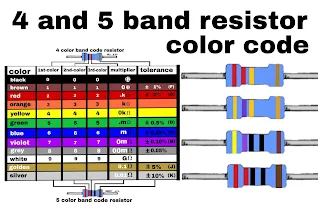4 and 5 band resistor color code calculation chart
Demystifying the 4 and 5 Color Band Resistor Color Code Chart
Introduction
Resistors are fundamental components in electronics, playing a crucial role in controlling the flow of electric current. To understand and work with resistors effectively, it's essential to decode their color codes accurately. In this blog post, we'll dive deep into the 4 and 5 color band resistor color code chart, unraveling its mysteries and equipping you with the knowledge to read and use resistors confidently.
**Table of Contents:**
1. **The Basics of Resistors**
To appreciate the significance of resistor color codes, we'll start by revisiting the fundamental role of resistors in electronic circuits. We'll discuss how they limit the flow of current and why different values are required in various applications.
2. **Why Color Codes?**
Exploring the rationale behind using color codes for resistors, we'll understand why it's a practical and efficient method for identifying their values. This section will also touch upon the limitations of color coding.
3. **4-Band Resistor Color Code Chart**
We'll dive into the 4-band resistor color code chart, breaking down each band's significance. You'll learn how to read the color bands to determine a resistor's resistance value, tolerance, and more. Practical examples and exercises will help reinforce your understanding.
4. **5-Band Resistor Color Code Chart**
Building upon the knowledge gained in the previous section, we'll introduce the 5-band resistor color code chart. This chart allows for greater precision when determining a resistor's value and tolerance. We'll explain how the fifth band comes into play and walk you through real-world examples.
5. **Common Resistor Values and Applications**
Delve into the world of common resistor values and their applications. We'll discuss why certain values are preferred in specific scenarios, such as voltage dividers, current limiting, and signal conditioning.
6. **Tolerance and Precision**
Understanding tolerance is crucial for selecting the right resistor for your application. We'll explain how tolerance relates to the color bands and how to choose resistors that meet your precision requirements.
7. **Color Code Chart Cheat Sheets**
As a handy reference, we'll provide printable cheat sheets for both the 4 and 5 band resistor color code charts. These can be a valuable resource while working on electronic projects.
4 and 5 band resistor color code calculation chart
8. **Practical Tips and Tricks**
We'll share some practical tips and tricks for working with resistors, such as identifying damaged resistors, deciphering faded or unclear color bands, and using online tools and apps for quick value lookup.
9. **Troubleshooting and Mistakes to Avoid**
Learn about common mistakes and misconceptions when interpreting color codes and how to troubleshoot issues that may arise during resistor selection or installation.
10. **Conclusion**
In our conclusion, we'll summarize the key takeaways from this comprehensive guide to the 4 and 5 band resistor color code charts. You'll leave with the knowledge and confidence to identify and use resistors effectively in your electronic projects.
This blog post aims to empower electronics enthusiasts, hobbyists, and students with the essential skills required to work with resistors. Whether you're just starting your journey in electronics or looking to refresh your knowledge, this guide will serve as a valuable resource for decoding resistor color codes accurately and confidently. So, let's dive in and demystify the world of resistors!

Comments